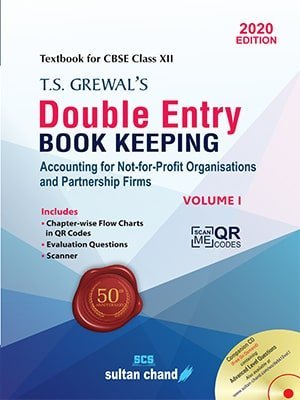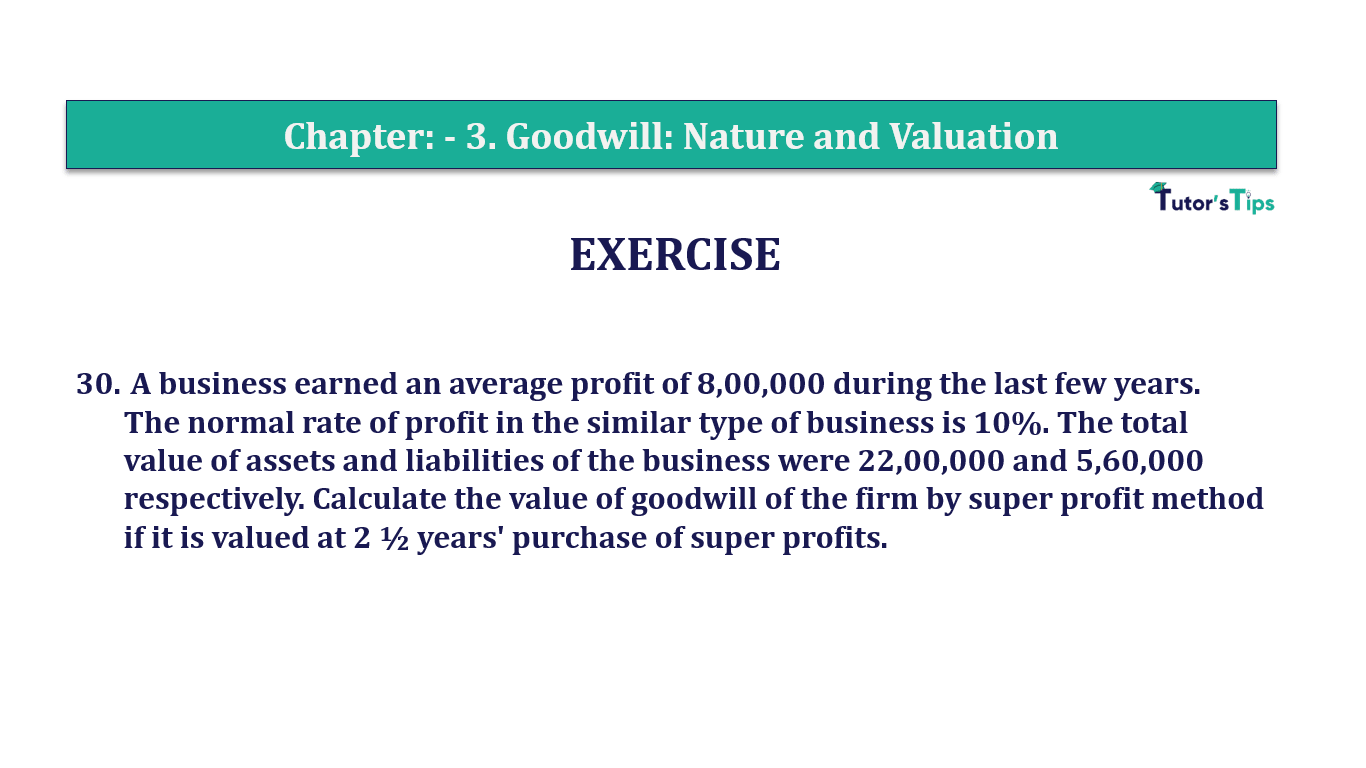Question 91 Chapter 5 of +2-A
91. Raghu and Rishu are partners sharing profits in the ratio 3 : 2. Their Balance Sheet as at 31st March, 2009 was as follows:
| Liabilities | Assets | ||||
| Creditors | 86,000 | Cash in Hand | 77,000 | ||
| Employees’ Provident Fund | 10,000 | Debtors | 42,000 | ||
| Investments Fluctuation Reserve | 4,000 | Less: Provision for Doubtful Debts | 7,000 | 35,000 | |
| Capital A/cs: | Investments | 21,000 | |||
| Raghu | 1,19,000 | Buildings | 98,000 | ||
| Rishu | 1,12,000 | 2,31,000 | Plant and Machinery | 1,00,000 | |
| 3,31,000 | 3,31,000 |
Rishabh was admitted on that date for 1/4th share of profit on the following terms:
(a) Rishabh will bring 50,000 as his share of capital.
(b) Goodwill of the firm is valued at 42,000 and Rishabh will bring his share of goodwill in cash.
(c) Buildings were appreciated by 20%.
(d) All Debtors were good.
(e) There was a liability of 10,800 included in Creditors which was not likely to arise.
(f) New profit-sharing ratio will be 2 : 1 : 1.
(g) Capital of Raghu and Rishu will be adjusted on the basis of Rishabh’s share of capital and any excess or deficiency will be made by withdrawing or bringing in cash by the concerned partners as the case may be. Prepare Revaluation Account,
Partners’ Capital Accounts and Balance Sheet of the new firm.
The solution of Question 91 Chapter 5 of +2-A: –
| Revaluation Account |
|||||
| Particular |
Amount | Particular | Amount | ||
| Building | 19,600 | ||||
| Provision for Doubtful Debts (Old) | 7,000 | ||||
| Liability for Creditors | 10,800 | ||||
| Profit transferred to | |||||
| Raghu’s Capital A/c | 22,440 | ||||
| Rishu’s Capital A/c | 14,960 | 37,400 | |||
| 37,400 | 37,400 | ||||
| Partners’ Capital Account |
|||||||
| Parti culars |
Raghu | Rishu | Rishabh |
Partic |
Raghu | Rishu | Rishabh |
| To Cash A/c | 48,040 | 84,860 | – | By Balance B/d | 1,19,000 | 1,12,000 | – |
| By Cash A/c | – | – | 50,000 | ||||
| By Investment Fluctuation Fund | 2,400 | 1,600 | – | ||||
| By Premium for Goodwill | 4,200 | 6,300 | – | ||||
| By Revaluation (Profit) | 22,440 | 14,960 | – | ||||
| To Balance c/d | 1,00,000 | 50,000 | 50,000 | ||||
| 1,48,040 | 1,34,860 | 50,000 | 1,48,040 | 1,34,860 | 50,000 | ||
| Balance Sheet |
|||||
| Liabilities |
Amount | Assets | Amount | ||
| Creditors | 86,000 | Cash (WN4) | 4,600 | ||
| Less: Liability | (10,800) | 75,200 | Debtors | 42,000 | |
| Employees Provident Fund | 10,000 | Investments | 21,000 | ||
| Capital A/cs: | Buildings | (98,000 + 19,600) | 1,17,600 | ||
| Raghu | 1,00,000 | Plant and Machinery | 1,00,000 | ||
| Rishu | 50,000 | ||||
| Rishabh | 50,000 | 2,00,000 | |||
| 2,85,200 | 2,85,200 | ||||
Working Note:-
Advertisement-X
Calculation of Sacrificing Ratio
Old Ratio of Raghu and Rishu = 3 : 2
New Ratio of Raghu , Rishu and Rishabh = 2 : 1 : 1
| Raghu’s Sacrificing Ratio | = | 3 | – | 2 |
| 5 | 4 |
| = | 12 – 10 | |
| 20 |
| = | 2 | |
| 20 |
| Rishu’s Sacrificing Ratio | = | 2 | – | 1 |
| 5 | 4 |
| = | 8 – 5 | |
| 20 |
| = | 3 | |
| 20 | ||
Sacrifice Ratio of Shikhar and Rohit =2 : 3
Share of Rishabh’s Share of Goodwill
Value of Firm’s Goodwill = 42,000
| Rishabh’s Share of Goodwill | = | 42,000 | X | 1 |
| 4 | ||||
| = | 10,500 |
Adjustment of Capital
| Total Capital of Firm | = | Rishabh’s Capital × Reciprocal of Rishabh’s Share |
| Capital bought by Rishabh | = | 50,000 |
| Total capital of Firm | = | 50,000 | X | 4 |
| 1 | ||||
| = | 2,00,000 |
Distribution of General Reserve
| Shikhar’s New Capital | = | 2,00,000 | X | 2 |
| 4 | ||||
| = | 1,00,000 |
Advertisement-Y
| Rohit’s Share of Goodwill | = | 2,00,000 | X | 1 |
| 4 | ||||
| = | 50,000 |
T.S. Grewal’s Double Entry Book Keeping +2 (Vol. I: Accounting for Not-for-Profit Organizations and Partnership Firms)
- Chapter No. 1 – Financial Statement of Not-For-Profit Organisations
- Chapter No. 2 – Accounting for Partnership Firms – Fundamentals
- Chapter No. 3 – Goodwill: Nature and Valuation
- Chapter No. 4 – Change in Profit-Sharing Ratio Among the Existing Partners
- Chapter No. 5 – Admission of a Partner
- Chapter No. 6 – Retirement/Death of a Partner
- Chapter No. 7 – Dissolution of a Partnership Firm
T.S. Grewal’s Double Entry Book Keeping (Vol. II: Accounting for Companies)
- Chapter No. 8 – Company Accounts – Accounting for Share Capital
- Chapter No. 9 – Company Accounts – Issue of Debentures
- Chapter No. 10 – Redemption of Debentures
T.S. Grewal’s Double Entry Book Keeping (Vol. II: Accounting for Companies)
- Chapter No. 1 – Financial Statements of a Company
- Chapter No. 2 – Financial Statement Analysis
- Chapter No. 3 – Tools of Financial Statement Analysis – Comparative Statements and Common- Size Statements
- Chapter No. 4 – Accounting Ratios
- Chapter No. 5 – Cash Flow Statement
Check out T.S. Grewal +2 Book 2020@ Official Website of Sultan Chand Publication








Leave a Reply